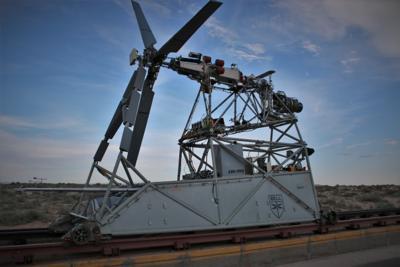Sat, Sep 16, 2023
The Past and Future of High-Speed Flight
Bell Textron Inc. has delivered a High-Speed Vertical Takeoff and Landing (HSVTOL) test-article to Holloman Air Force Base for demonstration and technology evaluation. Testing teams will leverage the Arnold Engineering Development Complex Holloman High Speed Test Track for purpose of vetting the test-article’s folding-rotor, integrated-propulsion, and flight control technologies at speeds representative of actual flight.

Bell executive vice-president of engineering Jason Hurst stated: “The HSVTOL test-article delivery and start of sled-testing operations serves as a major milestone in our mission to develop the next generation of high-speed vertical lift aircraft. Bell plans to showcase HSVTOL technology informed by more than 85-years of high-speed rotorcraft development and leverage lessons learned to produce a flying prototype with game-changing capabilities.”
Bell, by dint of the forthcoming sled-test regimen, seeks to validate key technologies by way of a full-scale, integrated demonstration in a representative operating environment. Bell plans for the test-article to execute a series of HSVTOL high-speed transition maneuvers—a first-of-its-kind capability for vertical lift aircraft. Prior to the HSVTOL test-article’s delivery to Holloman Air Force Base, Bell successfully completed functional demonstrations of the contraption at the company’s Flight Research Center.

Bell’s High-Speed Vertical Takeoff and Landing (HSVTOL) technology amalgamates the hover capability of a conventional helicopter with the speed (four-hundred-plus-knots), range, and survivability of a fixed-wing jet aircraft. Bell has developed high-speed vertical lift technology for more than 85-years, pioneering innovative VTOL configurations such as the X-14, X-22, XV-3, and XV-15 for customers the likes of NASA, the U.S. Army. and U.S. Air Force. The antecedent vehicles build on Bell’s proven history of high-speed flight, which extends back to the Bell X-1—the storied rocket-powered experimental aircraft in which then Captain Charles “Chuck” Yeager made the world’s first manned supersonic flight on 14 October 1947.
More News
Minimum Friction Level The friction level specified in AC 150/5320-12, Measurement, Construction, and Maintenance of Skid Resistant Airport Pavement Surfaces, that represents the m>[...]
Aero Linx: Airpower Museum The APM owns 30 acres on Antique Airfield, including the south half of the N-S runway. It consists of three hangars, an annex, and a library. The museum >[...]
Patient Told The First Responders That The “Man Who Was In The Plane Was Flying At The Time Of The Accident And Had Overshot The Runway They Were Attempting To Land On.&rdquo>[...]
Klyde Just Can't Believe This Has Gotten To This Point... FMI: www.klydemorris.com>[...]
Also: Duffy Wants $$$, KS Airports, Morningside U’s Aviation School, New Airstrip In ID After 6 were killed in a helicopter crash over the Hudson River, several US Representa>[...]
 ANN's Daily Aero-Term (06.02.25): Minimum Friction Level
ANN's Daily Aero-Term (06.02.25): Minimum Friction Level ANN's Daily Aero-Linx (06.02.25)
ANN's Daily Aero-Linx (06.02.25) NTSB Prelim: Champion 7ECA
NTSB Prelim: Champion 7ECA Classic Klyde Morris (From 06.10.22)
Classic Klyde Morris (From 06.10.22) Airborne 05.30.25: Anti-Helicopter Bill, PW Strike Done, All-Electric Bristell
Airborne 05.30.25: Anti-Helicopter Bill, PW Strike Done, All-Electric Bristell




